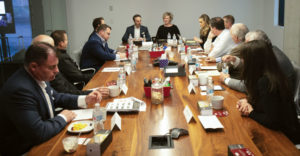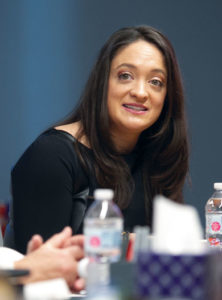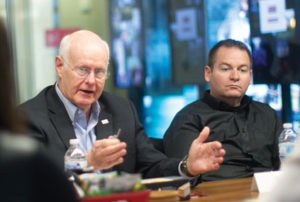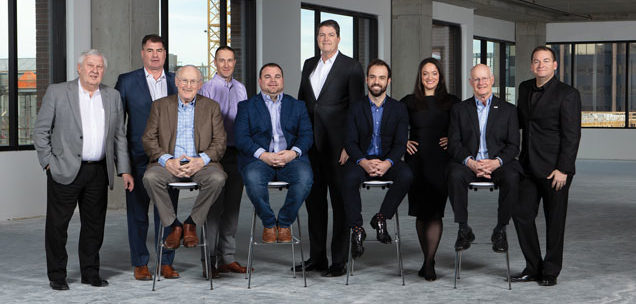
LEFT TO RIGHT: Bob Jaeger, WNW Hospitality Management; Michael Marquez, RLH Corp.; Patrick Bajdek, Hospitality Management Corporation; Ben Hrouda, Flywheel Capital; Taylor Davis, GBX Group LLC; Greg O’Stean, Interstate Hotels & Resorts; Cameron Lamming, RAR Hospitality; Amanda Marcello, RLH Corp.; Bill Hopping, W.R. Hopping & Co. Inc.;and David Byrd, Byrd Hotel Group
DENVER—What makes a memory? It could be the place, the people or even the scents—or maybe it’s something not so tangible. Nostalgia is a powerful force and triggers those often untapped places in the mind—places that respond to recognition, to comfort. However, a force just as strong could be the desire to create memories, to seek out this familiarity in the hopes of making a new nostalgia. For hoteliers, this isn’t a new impulse—it’s one they often try to trigger.
Held here at sponsor RLH Corp.’s headquarters, with additional sponsor support from Gallagher Real Estate and Hospitality Services, the Hotel Business Roundtable, “Signature Moments: Creating Memorable Stays,” was co-moderated by Hotel Business Editor-in-Chief Christina Trauthwein and Publisher Allen Rolleri. Industry leaders discussed how to extend these moments beyond the check-in to checkout window of time. How can properties create these moments and differentiate in a world of blurred brands?
Memories in motion
“We all have memories of a trip or vacation that was momentous, or changed your view on life, or changed the way you want to pursue your goals, your life,” said Cameron Lamming, president/COO, RAR Hospitality. “Each hotel has an opportunity to create an experience; it’s sort of a duty at this point.”
The methods of execution are the differentiators, with each brand—and even each property—coming up with different ways of creating this signature moment.
“Nostalgia grounds you; there’s that recognition and familiarity to the guest, and it’s good to embrace that,” said Amanda Marcello, SVP brand strategy, RLH Corp. “We’ve been talking about psychographics and these individual drivers that make them up beyond traditional demographics.”
She added, “It wouldn’t be uncommon for a baby boomer to come into a lobby, see records, pop art or mid-century modern art and say, ‘I recognize this.’ You might have that Gen Xer who could say, ‘My mother or grandmother had this,’ and then the millennial says, ‘This is so retro, this is cool.’ You have three different types of people in the same space—nostalgia doesn’t mean antiques, it means remembering a moment of time and bringing it back to today.”
Guests crave these moments, and even more so, making some sort of discovery. Regardless of generation or lodging preferences, the execs agreed that the search for identity is a natural human craving.
“We’re made of our past experiences,” said Bill Hopping, owner, W.R. Hopping & Co. Inc. “That’s a lot of the bait of repeat business: to create that moment that was part of your past, that was a favorable thing, that you want to go through again. While we have that nostalgic thing as our background, what we want to do is create new nostalgic moments [for]the future. The thread between those two is the emotional link that we all strive for.”
Hopping added, “Life is not the passing of time, it’s the collection of moments. What causes that emotional response in you? That’s our real job now: to go from customer service to customer experience to emotional connection.”
Emotions also serve as marketplace differentiators, with hotels injecting human elements into a guest’s stay. “The industry’s biggest advantage over short-term rentals is that those can’t create emotional connections,” Hopping said. “They create use of their apartment or house for a short period of time, but we have the ability [to do more]because we can reach out, hire qualified people and give them permission to create those moments at the property level.”
Brand identity
Just as important may be discovering a brand’s identity and relaying that to guests throughout their stay.
Marcello said that RLH Corp. adopted the term “Signature Moments” as a result of delivering the unexpected to guests and creating a sense of brand identity, with a large portion of its business in conversions.
“‘Signature Moments’ was developed to make sure conversion properties have created a common thread between the guest experience—from their arrival to their stay—and places where we could implement things that we knew were on-trend and relevant to the industry and guests,” she said.
“We’re doing something as a company that’s a little unexpected; a guest will say, ‘It’s not Folgers, it’s not Starbucks, it’s a brand a little bit unique to this particular hotel I’m staying in.’ That was purposeful and why we coined that term,” Marcello said.
This common thread should extend to all areas of hotel operations, Lamming said, since it’s critical to keep identity consistent and digestible for the guest.
“Identity is the foundation of every decision made in a hotel; your identity should bleed across the entire property,” Lamming said. “You need to have a storytelling idea behind it—it’s less about the grand finale and more, ‘Here’s the storyline and emotions you will feel when you walk into this space.’ The hotel industry really is the only industry that hasn’t done this. As soon as you connect with the guest and who they are, you get an immediate sense of loyalty.”
While certain features may spark memory and emotions, industry leaders were unsure if these moments are completely centered around amenities or fit more into the category of brand standards.
“There’s a difference between signature items and signature moments,” said David Byrd, principal, Byrd Hotel Group. “What [brands]call signature items are really just brand standards and marketing pieces that constantly hit you over the head; it’s overkill.”
While some marketing ploys may be redundant, creating a sense of recognition for guests is pivotal in a world where new brands are as common as lobby bars.
“How do you create consistency, brand awareness?” asked Michael Marquez, SVP of development, RLH Corp. “In this sort of brand-blur marketplace, we want to allocate resources toward a common experience that guests can count on. None of this is a bible.”
Greg O’Stean, chief development officer, Interstate Hotels & Resorts, warned that hotels, however, need to be cautious of an experience that’s too familiar, as certain experiences don’t always translate across hotel properties.
“If all the brands continue to expand and blur and have a brand mandate for something that says, ‘All hotels in this brand have to smell like apples in the morning,’ then you’ve gone away from the concept,” he said. “The concept should be that you need something local. It’s that moment—whether it’s a food or scent or music—that moment the guest pauses and says, ‘I’m not going to see this at the next place I go.’”
Marcello agreed, noting the importance of bringing locality into hotels even in places as personal as the guestroom, adding an additional signature moment to a guest’s stay. However, she agreed with O’Stean and recognized that this doesn’t always translate. For example, including skiing gear in an Atlanta or San Francisco guestroom just wouldn’t make sense.
“Location is so critical—is there local buzz in this marketplace?” Marquez asked. O’Stean agreed, but said that hotels and staff need to take a more proactive approach. While location certainly matters, even if a hotel is located in a vacant office area, properties have the ability to draw in nearby flavors and guests.
“At a good hotel, the local talent has to help it evolve and breathe and become a living part of the community,” O’Stean said, referring to mixologists who use social media as a platform for showcasing not only the hotel’s space and menus, but also using their online followings to reach those in the area.
“Greg brings up a good point about being agile, proactive,” Marquez said. “Some are timeless, some are temporal. As long as everything we do has that return-on-investment feel for it, we have to ask: Is this real?”
Whether fleeting like a nightly special or more grounded like an F&B fixture in the community, authenticity has to play a role.
“You have to be genuine wherever that hotel is,” said Ben Hrouda, managing partner, Flywheel Capital. “It’s hard in today’s world when today’s brands have a merchant type of product. You need to bring the microclimate into your hotel. If you don’t do that, you’re missing a huge opportunity.”
He continued, “We’re all talking about fads and signature moments, but it’s hard to quantify around all of this.”
Facts vs. fads
So how does a brand create consistency while also remaining true and relevant to the local flavors and attractions? Hotels may decide to look to guests for guidance, who are usually the greatest indicators of what works versus what doesn’t and what’s trendy versus what’s here to stay.
“We can build for it [brand consistency], we can train for it, we can market it, we can improve upon it,” Marcello said. “The signature moments have to be relevant to the brand, so that’s understanding who our audience is, what’s the demographic of who’s traveling here and what location we’re in.”
She expanded on the notion of fads but explained the necessity of easy entry points that don’t require too much investment for brands to test and trial.
“Two to three years from now [fads]may fall out of favor,” Hrouda said. “You have to be flexible enough to change; the pace of change will never be as slow as it is today.”
Taylor Davis, VP of real estate originations, GBX Group LLC, experienced a local fad firsthand at one of his company’s properties. A mural at the Catahoula Hotel in New Orleans drew in both tourists and locals alike for a chance to take an Instagram picture next to the larger than life piece of art. “Eventually, people stopped showing up,” he said.
Hopping advised not to get too caught up in this, but to look at business broadly and with less emphasis on the actual items. “Sometimes it’s amorphous [ROI]: It’s not the envelope, it’s what happens within it,” Hopping said. “Don’t measure ROI in the short term, but create a repeat business pattern that brings them back. It’s a lot of judgment because we don’t know why [a guest]came back, but we know the numbers are going up.”
Going viral
It’s difficult, if not impossible, to determine what’s going to be a hit either in-person or online. Much like the mural, many features lose steam after making it big. What pieces last, however—and even those that have a short shelf life—come about on their own.
“I don’t know how you would create that in different settings,” Davis said, referring to those “Instagrammable” moments. He added, “What’s the key? It wouldn’t be unique, and everyone would be doing it if you could predict it; it’s difficult to plan.”
Less of a fad and more of a community staple, Byrd described a signature staircase in one of his properties also used for photo ops, especially for wedding portraits. Despite brand pressure to renovate and do away with the staircase, Byrd said for some reason guests love it, so it stuck.
“Signature moments can’t be branded; you can’t create a viral video—you just don’t know what’s going to be viral. It’s organic, something hits or it doesn’t,” he said. “You never really know what’s going to resonate with people. You can’t duplicate it [the staircase].”
Lamming said that part of a good travel experience is for guests to discover what the locals do—whether it’s posing with a mural or a grand staircase—which can be reinforced with a brand’s social media strategy. Responding to guests’ social media posts, reposting and even creating online contests can be part of the mix, giving guests an opportunity to create a more hands-on signature moment.
“If it’s too promotional and all you’re seeing is a hotel room or an exterior [on social media], it’s only going to take you so far,” Marcello said. “A good influencer strategy can be planned, but you have to make time for those local, organic, authentic experiences that [show]we’re not just a big company.”
Bob Jaeger, president/managing partner, WNW Hospitality Management, said social media’s importance is about how consumers communicate with other users and experiences that are specific to brands.
“You want your guests to take away and spread out on social media or verbally how great a stay they had,” Jaeger said. “Brands are now pushing out to their elite guest a trail of their stay; they earn, and now they can do something to create a once-in-a-lifetime kind of moment. Each brand has its own thing.”
Service as a staple
Each component of creating a signature moment is distinct and serves a purpose, but the execs agreed that it ultimately comes down to service, which creates a collection of truly memorable ones.
“When you think about growing brands today, especially boutique and lifestyle brands, they’re not hiring typical positions,” O’Stean said. “It’s almost like a casting call; you’re looking for someone who has that service heart. Most of the people who are applying for those customer-facing positions, they’re not necessarily aspiring to a career in hospitality. You can try to train it, but then it’s not genuine.”
He added, “It’s not just the parts, it’s the people that get that vision. If you can’t deliver it with the right people, you’ve wasted your time and money.”
The execs acknowledged the industry-wide decline in good service. Some suggested this is the result of labor shortages or an idle work ethic, or, possibly not, with the problems filtering down from management.
“We’ve lost sight of service,” said Patrick Bajdek, VP of development, Hospitality Management Corporation. “You’ve got to train your staff. You need to buy into this program so they can sell it to the consumer. If they don’t buy into it, it doesn’t matter what the fad or trend is if they don’t deliver.”
The key to getting the service side back may be closer than many execs think, with the answer embedded in the very thing that brought them all here: hospitality.
“We have to be careful because standards are not moments,” Hopping said. “People relate to eyeballs better than cotton balls. What a smile and eye contact say to somebody is that we’re glad you’re here—isn’t that what our business is?”
He continued, “You have to hire well and have an overall philosophy that starts at the top of the chain and goes right through the management company and property level.”
Jaeger understands this type of service as what will ultimately set hospitality apart from all other industries, especially other models that are demanding more of the marketplace.
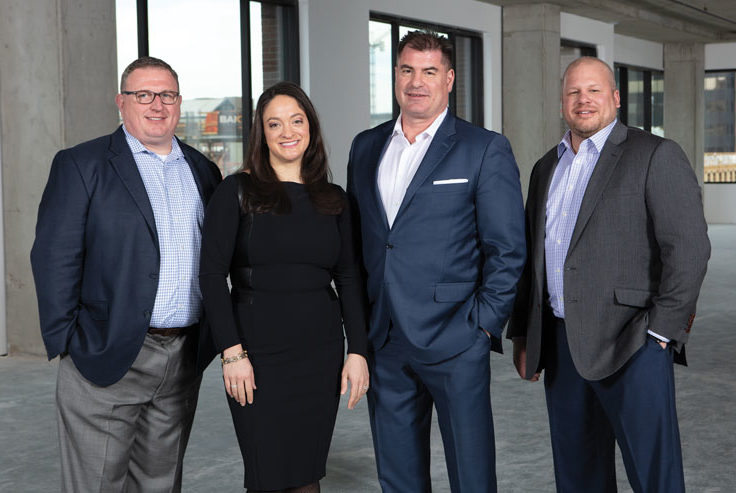
LEFT TO RIGHT: Roundtable sponsors Bob Donoghue, Gallagher Real Estate and Hospitality Services; Amanda Marcello, RLH Corp.; Michael Marquez, RLH Corp.; and Scott Armin, Gallagher Real Estate and Hospitality Services
“The real moments come with human interactions,” Jaeger said. “It never goes out of style to have good service. Airbnb is a very successful model, but it’s devoid of human interaction.”
Marquez suggested that hotels incorporate service and operations into signature moments themselves—perhaps incorporating a power word for employees to use with guests or another service feature that extends across all properties rather than just putting a bike in the lobby.
Others agreed that a signature moment doesn’t even necessarily have to be in the hotel; it could be the hotel itself or, possibly, the way guests relive their stays.
“It may not be exactly the signature moment you create in your hotel, but your hotel could be a vehicle for that,” Lamming said. “So long are the days that a hotel is a means to an end where it’s a place to stay before going from point A to point B within a city. It needs to be part of that destination decision. Our goal is simple: When someone’s talking about their vacation, our hotel needs to be a part of that conversation. It’s not a single moment; it’s creating that environment.” HB


